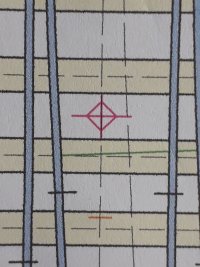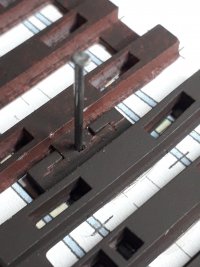I again had trouble with the L1 chair, got through 5 before managing to get the loose jaw fitted.
@Steve_Cornford
Hi Steve,
Looking good.

The L1 chair differs from all the others in that the pin and slot run down at a 5 degree angle. It is helpful to know this when pushing on it:
The angle was necessary because of the closeness of the jaw to the end of the chair. There is also a slight vertical kink in the pin at the top. I left this in because I thought it might help to lock the jaw in place. Perhaps that was a mistake.
In my tests it worked ok. But of course you are using a different batch of resin, on a different printer, at a different temperature. It all adds up. That's why you may need to tweak the pin clearance settings to suit your conditions -- click the
loose jaws... button:
Those settings apply to all the loose jaws -- there isn't a separate setting for the L1 chairs. It now occurs to me that the angle on the pin may make a difference and require separate clearance settings for L1. I will get that option added in 241b. This is what I mean by still having so much testing and learning to do.

If a pin breaks off it should be a loose fit in the slot, and be easily pushed out with a bit of wire from the top or the bottom. On my chairs a broken pin will actually fall out of the slot with a shake. It is the key clipping against the rail which makes the tight fit.
If your pins are not loose enough to do that, it probably means you need to adjust the clearance settings as above.
We might perhaps print a pin pusher-outer tool.
Some other thoughts -- the angle may reduce the effectiveness of the washing. It would take only a thin film of uncured resin left in the slot to significantly affect the pin clearance. I have a full 2 litres of IPA in the first tub and vigorously plunge the plate up and down a few times to force wash through the slots before doing the normal rotary swirl wash.
The XN chair is only strictly symmetrical if its centre is exactly on the centre-line of the knuckle bend, and it is for a regular-pattern crossing. However the differences are very small in 4mm/ft scale, and probably smaller than the resolution of the printer. Which means it is effectively symmetrical for practical purposes. It might even fit better the wrong way, if the rounding effects of the printer resolution so conspire. It may also depend on which way round you have the raft on the build plate, across or along.
It's a good idea to run a marker pen along one end of the plugs while they are still on the raft.
How is the press fit of the chairs in the sockets? I have fretted more about that than the pin slots, so I'm a bit surprised that you mentioned the pin fitting and not the chairs.
Is that a resin-printed base which you have sprayed brown, or are you now FDM printing?

cheers,
Martin.




 Search
Search

